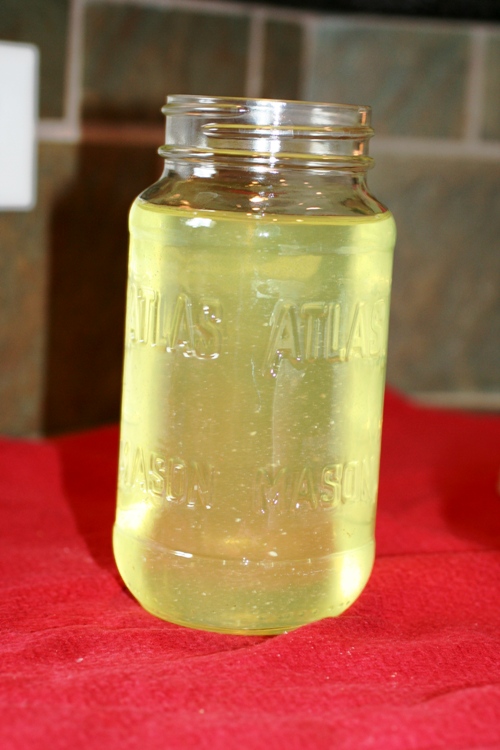 Do you remember that whey runoff from the homemade yogurt I made? Have you ever wondered what to do with the whey protein from things like yogurt. Well, I asked my friend Calie how to use it and why. I just love what she came up with! Checkout the suggestions below on ways to use the leftover “whey” from making things like homemade yogurt.
Do you remember that whey runoff from the homemade yogurt I made? Have you ever wondered what to do with the whey protein from things like yogurt. Well, I asked my friend Calie how to use it and why. I just love what she came up with! Checkout the suggestions below on ways to use the leftover “whey” from making things like homemade yogurt.
 If you’ve made homemade yogurt or cheese then you’re probably familiar with the leftover whey you get from making it. Curds and whey are the solid and liquid parts of the milk. You’ll recognize it as the yellowish liquid run-off that most people discard. But it’s more than run-off. It’s a sign of your yogurt’s purity and it’s packed with nutritional value. Whey is a complete protein lush with amino acids. Before you pour it down the drain stop and consider these healthy uses for your leftover whey.
If you’ve made homemade yogurt or cheese then you’re probably familiar with the leftover whey you get from making it. Curds and whey are the solid and liquid parts of the milk. You’ll recognize it as the yellowish liquid run-off that most people discard. But it’s more than run-off. It’s a sign of your yogurt’s purity and it’s packed with nutritional value. Whey is a complete protein lush with amino acids. Before you pour it down the drain stop and consider these healthy uses for your leftover whey.
 Can you save money while still eating healthy? You bet! I’ll tell you all my secrets in my book, Saving Savvy.
Can you save money while still eating healthy? You bet! I’ll tell you all my secrets in my book, Saving Savvy.
- Reincorporate all or some of the whey back into your yogurt. Keep in mind that the more whey you add the thinner your yogurt will be.
- Soak your grains or beans in it. Soaked grains (oatmeal, rice, quinoa) and beans take less time to cook, are easier to digest, and allow our bodies to utilize more of the nutrients. Add 1-2T of whey and just enough water to cover your grains or beans. Soak overnight.
- Use in place of water in just about any bread recipe or other baking. The Nourishing Traditions cookbook is a great resource for recipes that incorporate whey and all of its nutritional value.
- If you’re already making homemade yogurt, why not try homemade ricotta cheese. It’s made from leftover whey, and it’s delicious in lasagna or other pastas.
- Season your whey with garlic or other spices and use it as a marinade for meat. This works especially well with frozen meats. The enzymes will help bring out the flavor.
- Use in place of vinegar to pickle your vegetables.
- Add it to your bath water for healthy, glowing skin.
- Use it to water your garden or compost pile. This is especially useful if you have a lot of whey to use up.
- Drink it. Some people drink whey straight up, but I’ve found it does not taste very good. Add it to a smoothie for all the nutritional value minus the taste.
*Tip: Store your whey in a glass bottle in the refrigerator for future use.
Whey Delicious Oatmeal Recipe: Soak steel cut oats overnight in one tablespoon of whey and enough water to cover the oats. Follow the cooking instructions for your steel cut oats (you can use whey in place of water) in the morning and add coconut oil, cinnamon, and dried fruit for extra nutritional value and lots of flavor. It’s delicious!
How have you used leftover whey?
You might also like:
- Organic and Natural Coupons
- How to Get Your Kids to Eat Healthy Foods
- Easy Vegetarian Recipes
- Natural Cold Remedies
About Calie at Broccoli Cupcake:
Broccoli Cupcake is a place to find and share information about living a happy, healthy lifestyle. The contents are fueled by Calie’s personal journey to improve her health and the health of her family. Calie is a work-from-home media relations consultant, mom to two unruly boys and health and wellness junkie. Tune in every other Wednesday at 7:30 a.m. for Calie’s healthy living tips on Fox 17 Tennessee Mornings.




I am so excited that you are positing about real food traditions like Nourishing Traditions etc. This info needs to be out there so more families will become healthier! Thanks Kelly!
Do you know how long the whey will be good if kept in the refrigerator?
I’ve kept whey from yogurt in a glass jar in the fridge for over a month, but I’ve been told it will keep in a well sealed jar in a fridge for several months.
Danno
I loved the yogurt btw, but I have a question about the Whey.
Can I use the Whey leftover to replace the powder whey for a protein shake?
Does whey have enough Protein, to do that ? & how can I find the nutritional information of whey?
Yes, you can use the whey run-off to make a protein shake. A half-cup of the whey run-off will contain about 12 grams of protein. It will also have some fat and carb content, with the fat content varying based on what type of milk you used. However, it is a very balanced food. It will also contain some calcium and some of the vitamins from the milk so it is a good source of nutrition.
When my wife makes yogurt, I use the whey runoff to make protein shakes. The taste is a little tart but neutral, so the sky is the limit for what flavorings you can add to the shake.
According to the USDA, 8 oz of whey has only 2g protein, not 12.
Honestly, I just drink it straight up when my cheese is ready. Then I save in a jar and take a big slug every day. I think its very fortifying now especially in Coronavirus days.
Hi! I’m new to your blog, but I’m so excited to have just stumbled upon it. I found it as the second listing when I did a Google search for “uses for whey”. I am a real food blogger and I base my view on food on the work of Weston A. Price and Nourishing Traditions. I am really excited to explore you blog and hopefully get to know you! Thanks for this great post, BTW! ~Jessica
Replying to Whitney’s question:
Hey there. I’m no professional nutritional or anything 😉 but if memory serves correctly, there are two forms of protein in milk.
– casein
– whey
In the culturing process, the two forms basically just go their separate ways, so while I imagine that there is plenty of H2O in the whey, there would likely be a significant contribution of protein too.
SIDE NOTE: (on soaking/cooking legumes)
Mind your PH. If your solution is too acidic, the beans will stay crunchy no matter how long you cook them (well, I’m sure they’d reach the soft point at some time :), so if adding yogurt whey, maybe also add a little baking soda too to help balance it out.
Just my two cents 🙂
~ Mo
I used whey to make broccoli soup. Just boiled the broccoli until soft, then blended with my stick blender and added a bit of milk and a touch of cream. Season to taste and it’s delicious. I’ve mixed it with flavored drink mix for my son and also froze the same mixture for popsicles for him. I think you could use it in any soup recipe as a broth substitute. And, yes, when I used it to cook beans, the outer skin stayed tough. I won’t do that again! I will try cooking my oatmeal with it, though, thanks for that tip! And marinating meat…who knew?
Is it okay to freeze whey? I made two batches very close together and haven’t used all my whey yet.
I just made yogurt and used the whey, straight up, 2c. with 1 c. grits and it turned out okay. My husband also used the whey in our homemade pancake recipe in place of the milk/water. I was surprised at how thick and viscous the whey was. We LOVE steel cut oats; can’t wait to try it in that. Good to consider about the pH factor.
ooh, love the pancake idea. Made those this morning and didn’t even think about it. Thanks! I find more and more uses for it everyday. Such a shame that I used to throw it away.
i have used leftover whey (from making cheese) in tomato soup and it is SUPERB.
my question is – is the whey from cheese-making the same as the whey from making greek/strained yogurt?
I’m sure someone with some actual cheese-making EXPERIENCE can say for certain, but my thoughts are that there will be a difference. (My experience is limited to yoghurts, sour creams, buttermilks, and sour milks.)
The first thing that comes to mind is simply the salt content.
None is used in yoghurts (although it is occasionally added at serving time).
Other than that, yoghurts are bacterially cultured, and if I understand correctly, cheeses are enzymatically cultured.
While I BELIEVE either can be used in most occasions (if the salt issue is balanced out), I’d venture to guess that they are, in fact, significantly different. I’d imagine that they would each end up contributing to a dish in their own wonderful way.
Like you, phatmike, I’m also be interested to hear what others have to say on this topic.
~ Mo
Thanks for posting this! I’ve only made two batches of yogurt and I threw away the whey from my first batch. I measured it this time and thought – SURELY there is a way to use this stuff! Enter: google.
The funny thing is, I have poured my whey (all 2.5 cups of it) in the IDENTICAL bottle you have pictured above. It’s sitting in the fridge “wheyting” to get used. I love the smoothie and pancake ideas!
I’ve also read that it makes an excellent (hair) conditioner…
Oh! I love the conditioner idea!
Anyone else heard of it being used for that? I’ve never made yogurt before but cannot wait to try it. I recently got laid off and am looking SO forward to being home more and having the time to try all these great recipes/ideas!
curious if there is any yogurt culture still active in the whey that can help in making more yogurt? anyone know??
have always used the whey for various things, even to start my baby chicks. it really helps with sickly kittens too. they don’t always like the taste but they go back for more every time.
even used it on baby ducks two years ago and they sure perked up from wobbly legs because their body grew too fast for their legs to hold them up so the protein in the whey sure helped them come out of it.
Great article. I strained yogurt to make frozen yogurt and had a feeling I shouldn’t throw out the “water,” but I didn’t know what to do with it. I am going to try it with oatmeal.
Hi Good day I’ve been searching for days since I found out about the benefits of whey (last week). I now know it can be added when making homemade mayonnaise which makes the mayo last longer. My question now is: Can I also add to home made egg custard; cream cheese frosting (as in cake decorating/ icing)? What other home made products containing dairy items?
Many many thanks. Jennifer
I’m still not satisfied with making ricotta etc using whey from strained yogurt. Seems there is too much hear-say. Whey from strained yogurt is translucent with little or nothing in suspension. How can I end up with a white product such as ricotta??!!
Thanks for the reply by author Ray, however, I’m not a ‘shake’ person, my query was for egg custard, and cream cheese frosting, (see above)
I’ve now tried adding whey to egg custard, and I think that is a no, no as it made (I think) the custard I normally make, very runny. The cream cheese frosting I am still out on; I made (with whey) over 3 weeks ago, and so far it still tastes yummy.
I also agree with Ward, I do not think ricotta from yoghurt whey works at all. I have made it with full cream milk and thin cream, it fact that way is FANTASTIC! & I’ve used that whey to make unbelievable pancakes. I can now say ‘been there, done that’.
Whey (from yoghurt) lemonade is the tops, so yummy. I’m also used (yoghurt) whey for bread, and it is the only bread I will ever make. I’ve made more bread and rolls in the last 3 weeks than I have in my life. Malt loaf made with whey is unbelievable, And I don’t normally eat bread, or cakes, never mind make it.
About making RIcotta – I have a few cheese books, and the directions are very particular. Ricotta is made from whey, but it (and other cheeses made from whey) have to be made from whey less than an hour old. It has to still be warm when you make the whey cheeses. Whey from yogurt will not work because it is cold. Save that whey for another purpose. Normally, whey to make cheese is whey leftover from other making other cheeses.
I just made fantastic Ricotta – tried 2 recipes before this one worked. 8 cups of whole organic milk and 4 cups of buttermilk. Heat to 190 – don’t stir at the end or you will break the curds. Carefully lift the curds into 4 layers of cheesecloth and let the whey drain for 30 minutes. The ricotta is delicious but the real treat is the whey. I find it to be such a pure, satisfying food. I drink it straight.
Thank you for sharing!
I LOVE that you can make Ricotta cheese with it since I just found a no-rise-quick-and-easy recipe for cinnamon rolls that takes ricotta!
If I have an allergy to dairy and gluten, should I avoid whey, as it is made from milk or yogurt?
I’d imagine that the key factor of whether your dairy allergies should prevent you from enjoying whey would be the root of your sensitivity.
If you’ve been formally diagnosed with an ALLERGY to dairy, the doctor should have spelled out the details for you … which constituents in dairy effect you, in which manner, and to what end. For example, if you’re allergic to the lactose, then you should be fine on whey, but if it’s a true allergy, it might not be worth the risk. If your allergic to casein, then you’re probably just plumb out of luck 🙁
However, if you suffer with a SENSITIVITY to dairy, then it might be worth just trying a little. The same expectations would go for sensitivities too … if it’s a lactose sensitivity, you’ve got a really good chance of success. If it’s a sensitivity to casein or some other element of dairy, then the odds might narrow considerably.
Actually, those unable to digest lactose should stay far away from whey. It is very high in lactose.
Really ??? Wow! I guess you learns something new every day 🙂
Thanks, Christina.
Sooo, aside from that oopsie, I’d still suggest identifying whether you have an Allergy or a Sensitivity …. and which constituents in the dairy give you problems.
Then you can look into the science behind it rather than let someone else’s mistake (::blush::) lead you astray. 🙂
Best of luck.
~ Mo
It’s more than certainly worth looking into (or asking your doctor/allergist about). My son has problems with dairy but is able to eat yogurt because the heating of the milk breaks down the specific dairy protein to which he reacts. Obviously, whey would be fine for him since it’s found in yogurt.
Coffee flavoring
I just add some sugar (about 1/2c per quart whey) and vanilla extract about 1/2Tbs (any other extract would taste great too) heat on low to dissolve sugar. Then cool and poor into a jar and keep in refrigerator. Adding it to coffee or oatmeal.
Hmmm, tried making ricotta, but only got about a teaspoon of it. I originally started with about 3/4 gallon of milk for the yogurt.
I make Whey everyday at home and drink. I use about 1/4 of gallon milk and add 2 spoons of pure lemon juice at the time of boiling. It separates and get about 8-10 Oz of Whey. My question to nutrition specialists: 1. How good it is in terms of nutrition value. 2. Long term health benefit 3. Content of protein 4. any side effects 5. Should everyone drink about a small glass of home made whey
there must be more uses! When I lived abroad where they’ve made yogurt for a century, the even have a soft drink made from whey. Feeding it to pigs is commonplace. When I made bread I always used whey . Gotta ask my Swedish connection!